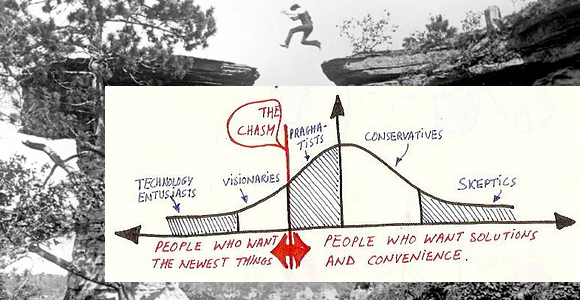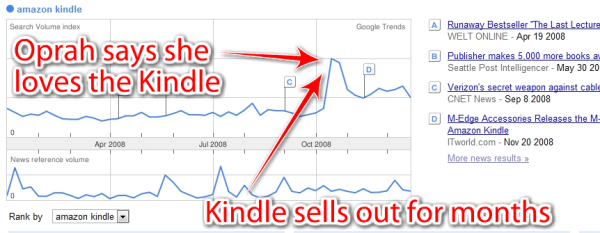Here Is The Real Reason Why Your Cleantech Is Not Reaching The Mainstream
By George Gray
Let’s be honest. Some clean technologies just stink.

A lot of the time, though, it’s not that the technology has a funky smell but the business has the wrong direction.
These misguided projects show some tell-tale warnings that a keen eye can spot. These signs aren’t always as obvious as you would think. They can be hidden deep amongst sound rationale.
However, this post should help you to sniff out the technology businesses that are, unfortunately, just plain stinkers.
Clean technologies are commonly designed to meet mass market needs by replacing current products and services. This can cause a marketing problem for founders. Slow growth can leave founders wondering if their product is actually as amazing as they initially thought.
But maybe you’ve just got your marketing strategy wrong.
Who is the technology for?
The all-to-common answer to this question is that “my technology is for everybody”.
This belief is a seed for business disaster.
Yes, clean technologies can offer a lot of value to many people, so it is not that this statement is incorrect. More often than not, this answer is actually correct. The nuance here is that it is very hard to convince mainstream customers that your technology is indeed for everybody. Mainstream customers do not easily change their behaviour.
The well-seasoned entrepreneur and investor knows this. They are aware of the stubborn nature of mainstream customers, so they look out not only for innovative technologies, but also for those technologies that have a good strategic plan in order to get to market.
Marketing cleantech clearly has some challenges. Not only do technology founders have to innovate to create products that have environmental benefits, but they generally must also innovate a strategic plan to gain customers for their technology.
The answer does not lie in trying to sell to everyone. (At least not initially) But this is a mistake that many first-time entrepreneurs make. Instead of trying the “sell to anyone approach,” you’ll want to pick a smaller group of people and aim to first convert them into customers. Only once you’ve got a select group using your technology should you look to access the mainstream markets. The most difficult part of this process is what Geoffrey A. Moore calls “Crossing the Chasm.”
Making the Leap

“Crossing the Chasm” is a concept to explain what many technology companies struggle with. The problem is that you need an effective marketing strategy and distribution channel in order to cross the considerably large gap between the early market and the mainstream market.
“The number-one corporate objective, when crossing the chasm, is to secure a distribution channel into the mainstream market, one with which the pragmatist customer will be comfortable. This objective comes before revenues, before profits, before press, even before customer satisfaction. All these other factors can be fixed later – but only if the channel is established.” – Geoffrey A. Moore
Moore talks about how a founder’s objective should be to gain a small group of enthusiasts (early adopters) before looking to reach the more stubborn and sceptical consumers of the mainstream market. So, for clean technology to one day be adopted by a larger audience, you need to accompany the innovation with a solid marketing strategy.
The EV market is a great example of this. Companies like Telsa did not start by creating EV’s for the average American. That would be much too difficult to market and would have probably failed miserably like some earlier EV attempts did. Instead, Telsa focused on making a car that would offer significantly more value to an, initially, small group of enthusiasts.
Is the Tesla model repeatable for other cleantech businesses?
Not exactly. It’s very clear that every business will have different needs. However, there are some essential marketing principles that are important for cleantech businesses, especially in order to avoid the “my product is for everyone” mistake.
1) Start by targeting a Specific Market Niche.
For your technology to reach the mass market, start by focusing your marketing efforts on a specific niche which you can serve better than your competition.
“… by targeting a very specific niche market where you can dominate from the outset, force your competitors out of that market niche, and then use it as a base for broader operations. Concentrate an overwhelmingly superior force on a highly focused target.” – Geoffery A. Moore, Author of ‘Crossing the Chasm’
Most startups and early stage ventures do not have the resources to compete with established organisations for the mass market. However, a technology founder can search for a market niche that is underserved by these organizations. By using a selected market niche to build a base, you will be in a better position to target a mainstream audience.
2) Clarify the benefits of your technology to your specific market niche
Know how your technology will SIGNIFICANTLY improve the lives of the target customers in your specific market niche. Make sure to stress specific benefits of your solution, not just the product capabilities. People buy things that offer value, not features.
“Make things as [clear, and] simple [and repeatable] as possible, but not simpler” – Albert Einstien. [&Tony Seba]
You’ll want to make your message very clear in your marketing material — who your product is for and who it is not for. You’ll want to make this message easy to repeat so that people can easily spread the word about your product.
This can be in the format of”
“For (target customers) who (specific problem), the (name of product) offers a way to (unique value proposition “UVP”).”
The clearer you can make make this message, the easier you will make it for other people to start sharing it for you. This will allow word-of-mouth marketing to work in your favour.
3) Use case studies and testimonials specific to your market niche.

Testimonials are the best way to validate the benefits that you claim in your marketing material. Pick ones not only from happy customers but also from influencers that will boost your credibility. Pick ones with specific appeal to your selected niche.
Aim for the testimonial format of:
- Customer/Influencer story of specific problems
- How your technology solved that problem
- Why they were satisfied and would want to recommend it.
4) Ask for permission before marketing to your Market Niche.
Strapped for cash? Make your marketing count by only talking to those who want to listen. Tease customers with some benefits of your technology, then ask if they wish to find out more.
“Permission marketing is anticipated, personal, relevant” – Seth Godin, Author of Permission Marketing.
Modern marketing is not about shouting louder and being an attention seeker. It’s not about one-off transactions either. Instead, marketing is a process of building customer trust over time. Customers should enjoy receiving your marketing messages. It should be directed at your customer and offer them value.
You’ll want to make your marketing:
- Clear — Not full of jargon and confusing.
- Believable — Some groundbreaking technologies need explanation to show that claims are realistic.
- Exciting — Avoid being boring and add fun and humour to your marketing.
- Empathetic — Your marketing should not trigger guilt. Instead, you’ll want to keep things lighthearted and upbeat.
5) Build your customer base through Email Marketing
The best way to engage in permission marketing is through email marketing. People can choose to opt in to receive your marketing via a newsletter or email. Allowing that choice means that people you market to are willing to receive your messages, so they will be much more interested in what you have to say.
Email is great for marketing technology products. This is because you can provide more information about your technology and it’s benefits in an email than you can through social media marketing. Because with email marketing potential customers have made the decision to receive marketing messages from you they convert into paying customers at a much higher rate than un-targeted marketing efforts.
McKinsey & Company found that “email is almost 40 times better at acquiring new customers than Facebook and Twitter.”
6) Social media is still very important, just use it like a small town butcher would.
By interacting with individual customers within your targeted niche on social media, you can learn more about how to serve them and build valued relationships with initial customers.
“It’s still so rare for anyone to be personally acknowledged by a brand that the impact of such a simple, polite gesture on a customer’s buying habits could be huge.” – Gary Vaynerchuk, Author of Thank You Economy.
Not surprisingly, Elon Musk leads by example with this one. Musk has been known for replying to customer emails personally and even making product changes from customer feedback as shown in the recent tweet below.
Ad taken out in Palo Alto Daily by two Model S owners is right. Many of the suggestions will be implemented soon. pic.twitter.com/cF43PvJDgQ
— Elon Musk (@elonmusk) August 23, 2014
Because of this customer interaction, Musk was able to build even more trust with his customers.
Distribution
So far, we’ve covered some of the modern marketing tools that can be used to market innovative technology to a selective market niche. However, this is only part of the Crossing the Chasm strategy for cleantech products. One of the most important aspects of marketing is selecting an effective distribution channel to mainstream customers. Once you have used the marketing methods above to dominate a market niche, it’s time to use that as a base and reach out to mainstream customers.
Distribution channels — organisations in charge of making available and selling the products and services to the target customers.
In cleantech, distribution channels have 4 main roles: sales, logistics, finance, and support.
When choosing a distribution channel, it’s important to see it from your customer’s perspective and feel the pains they would have when trying to purchase your product. Like we mentioned in the beginning of this post, initially you will want to select a market niche to target. Listen carefully to these customers, as they will guide you to make distribution channel decisions that offer the most value. From this perspective, you can use that understanding to then develop your channel. The key is to talk to your customers and understand their needs. Then you’ll want to ask the following questions to access a potential distribution channel.
- Is there a strategic fit?
- Is there a product fit?
- Does it make financial sense?
Attention to detail is important when choosing a distribution channel. For consumer-facing companies, factors such as packaging and delivery can play a huge role in nailing the distribution strategy. You have to aim to delight customers and exceed their expectations.
Why is distribution so important?
The distribution channel that you choose can help expand your business. If there is a strategic fit, a product fit, and it makes financial sense, then chances are you’ll be be able to Cross the Chasm to the mainstream.
Don’t get caught in the illusion that it is easy.
You can always do the right things at the wrong time. If we realise that the marketing and distribution channel decisions are as equally important as the technological development decisions, we can dramatically increase the chances of a clean technology venture reaching it’s maximum potential.
Innovate, Innovate, Innovate
Just like with cleantech product development, there is no end to improvement. To stop innovating exposes yourself to the possibility of failure. Marketing and distribution play a key role in the success of a cleantech venture and deserve equal weighting of importance as the actual technological innovation. Some of these marketing and distribution improvements will be small and incremental, and others will be large and disruptive. Just like the disruptive technology innovations of solar power and electric vehicles, we should expect to see more disruptive business model innovations in the future of the cleantech industry. In order for cleantech companies to make the jump across the chasm to the mainstream market, they will need to understand the important role that marketing and distribution channels play.
“Innovation distinguishes between a leader and a follower.” – Steve Jobs
So, if you are in the cleantech industry, start thinking not only of technology innovation but also marketing and distribution innovation. How can you reach customers in a way that generates more value for them? What pains do your customers have when finding your products, learning about them, and purchasing them?
Most importantly, how do YOU think we can get more cleantech companies to ‘Cross the Chasm’ to serve the mainstream market?
P.S. If you’re interested in learning more about marketing and distribution, I discuss this and more in a new e-book — Engineer to Founder. For the readers of CleanTechnica, the book is “pay want you want” – so if you want, you can get it for free.
Have a tip for CleanTechnica? Want to advertise? Want to suggest a guest for our CleanTech Talk podcast? Contact us here.
Latest CleanTechnica.TV Video

CleanTechnica uses affiliate links. See our policy here.
